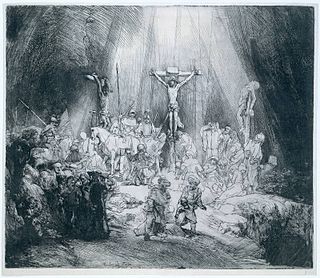
Gerbrand van den Eeckhout was a Dutch Golden Age painter and a favourite student of Rembrandt. He was also an etcher, an amateur poet, a collector and an adviser on art.

GovertTeuniszoon Flinck was a Dutch painter of the Dutch Golden Age.

John Runciman was a Scottish painter known for Biblical and literary scenes. His works include Flight into Egypt and King Lear in the Storm, both in the National Gallery of Scotland.

The Parable of the Prodigal Son is one of the parables of Jesus in the Bible, appearing in Luke 15:11–32. Jesus shares the parable with his disciples, the Pharisees, and others.

Henri Jozef Machiel Nouwen was a Dutch Catholic priest, professor, writer and theologian. His interests were rooted primarily in psychology, pastoral ministry, spirituality, social justice and community. Over the course of his life, Nouwen was heavily influenced by the work of Anton Boisen, Thomas Merton, Rembrandt, Vincent van Gogh, and Jean Vanier.

Jacob Isaackszoon van Ruisdael was a Dutch painter, draughtsman, and etcher. He is generally considered the pre-eminent landscape painter of the Dutch Golden Age, a period of great wealth and cultural achievement when Dutch painting became highly popular.

Abraham Bloemaert was a Dutch painter and printmaker who used etching and engraving. He initially worked in the style of the "Haarlem Mannerists", but by the beginning of the 17th-century altered his style in line with the new Baroque style that was then developing. He mostly painted history subjects and some landscapes. He was an important teacher, who trained most of the Utrecht Caravaggisti.

Adriaen van de Velde, was a Dutch painter, draughtsman and print artist. His favorite subjects were landscapes with animals and genre scenes. He also painted beaches, dunes, forests, winter scenes, portraits in landscapes, as well as mythological and biblical scenes. He belongs to a group of painters referred to as the Dutch Italianate painters, who combined Dutch agricultural landscapes with mythological or Arcadian scenes in Italian settings. His paintings are characterised by their delicate, careful composition and his mastery of lighting effects as well as the human figure.

Rembrandt Harmenszoon van Rijn, usually simply known as Rembrandt, was a Dutch Golden Age painter, printmaker, and draughtsman. He is generally considered one of the greatest visual artists in the history of art. It is estimated Rembrandt produced a total of about three hundred paintings, three hundred etchings, and two thousand drawings.

Jan Six was an important cultural figure in the Dutch Golden Age.

Jacob Adriaensz Backer was a Dutch Golden Age painter. He produced about 140 paintings in twenty years, including portraits, religious subjects, and mythological paintings. In his style, he was influenced by Wybrand de Geest, Rubens and Abraham Bloemaert. He is also noted for his drawings of male and female nudes.

The Prodigal Son in the Brothel or The Prodigal Son in the Tavern or Rembrandt and Saskia in the parable of the prodigal son is a painting by the Dutch master Rembrandt. It is now in the Gemäldegalerie Alte Meister of Dresden, Germany. It is signed "REMBRANDT F.".
Jonathan Janson is an American painter and art historian.

The Stoning of Saint Stephen is the first signed painting by Dutch artist Rembrandt, made in 1625 at the age of 19. One of his earlier works, it is an oil painting on a wood panel and currently exhibited at the Musée des Beaux-Arts de Lyon.

The dozens of self-portraits by Rembrandt were an important part of his oeuvre. Rembrandt created approaching one hundred self-portraits including over forty paintings, thirty-one etchings and about seven drawings; some remain uncertain as to the identity of either the subject or the artist, or the definition of a portrait.

The Raising of Lazarus is an oil-on-panel painting by the Dutch artist Rembrandt from early in his career; it was probably painted between 1630 and 1632. The work depicts the Raising of Lazarus as told in the Gospel of John, Chapter 11. It is in the collection of the Los Angeles County Museum of Art.

The Three Crosses is a 1653 print in etching and drypoint by the Dutch artist Rembrandt van Rijn, which depicts the crucifixion of Jesus Christ. Most of his prints are mainly in etching and this one is a drypoint with burin adjustments from the third state onwards. It is considered "one of the most dynamic prints ever made".
Gary Schwartz is an American-born Dutch art historian, who is a scholar of Rembrandt and art of the Dutch Golden Age.

David and Jonathan is a painting by the Dutch painter Rembrandt, made in 1642, now in the collection of the Hermitage Museum in Saint Petersburg, Russia. Painted on oak, it is one of the works, together with the Hellenistic sculpture acquired in 1850, The Venus de Taurida, with which the Hermitage began their collection in 1882.

The Parable of the Prodigal Son is an oil painting by the brothers Frans Francken the Younger and Hieronymus Francken II, now in the collection of the Amsterdam Museum. It was created sometime between 1610 and 1620 in Antwerp and was acquired by the Amsterdam art collector Adriaan van der Hoop in 1843, who donated it to the city in 1854. It is on long term loan to the Rijksmuseum.





















